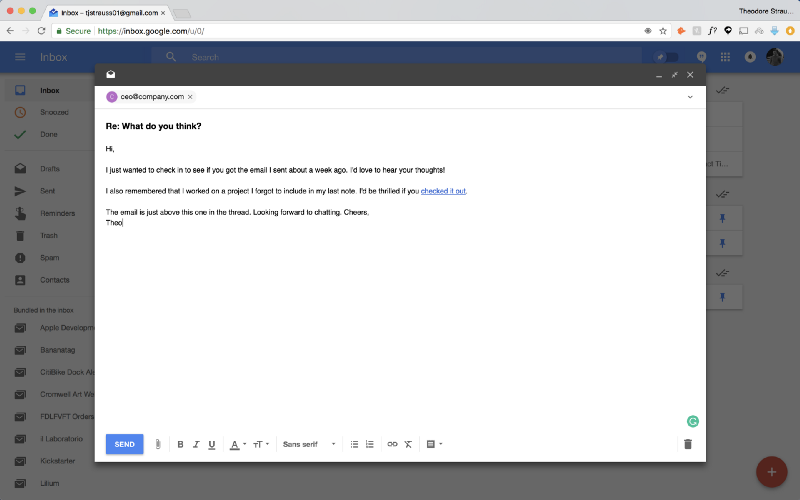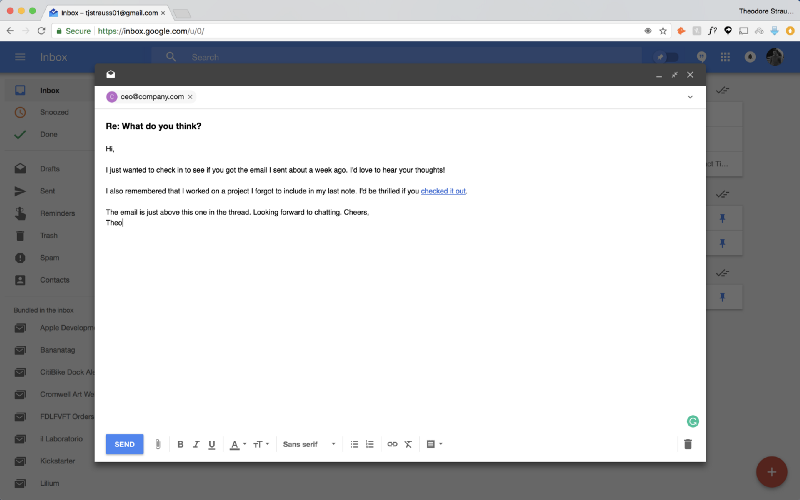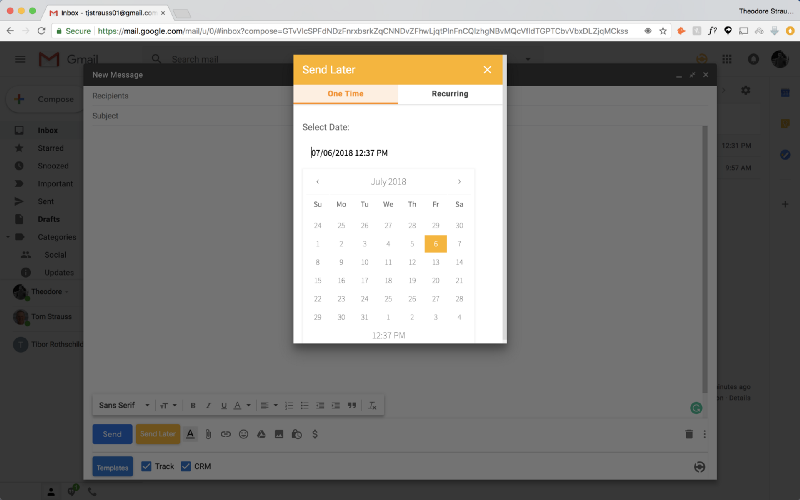By Theo Strauss
The Emailer’s Guide To The Galaxy: Part III

As I discussed in my previous two posts, I’m 17, so my network isn’t too big just yet. For me, cold emails are the easiest and most direct way to reach a founder. Over the past year, I’ve sent over 100 emails to CEO’s, founders, and heads of design, and have figured out how to ensure a response.
Contrary to what most people think, emailing isn’t as simple as writing, sending, and waiting. Once you click the send button, the journey’s only getting started.
Quick note: this is the third post in a series all about cold-emailing. If you haven’t read How to find any CEO’s email address in minutes or How to design a cold email for a CEO with a 100% read, click, and response rate, I recommend giving those a look before starting here.
This post is all about maximizing your chances of getting a response. So, we’re diving into the specifics of when to send your email, how to track it, and why you should follow up to strengthen your chances of hearing back. So, sit down, open Chrome, and let’s get to work.
Before clicking send
Right now, that send button you’re looking at does one thing and one thing only: moves your email from your drafts folder into your recipient’s inbox. To keep an eye on your email’s progress, that email needs to be tracker-enabled.
What is an email tracker?
At the most basic level, an email tracker, well, tracks your email. It tells you when it’s been opened.
But, as you go more in-depth, a tracker can reveal a bunch more info:
- How many times it’s been opened
- Where it’s been opened
- Who’s opened it
- When they went to your website
- Where they’ve gone on your website
Why are these things important? With data on where and when your email has been opened, you can infer if they are traveling, are at home, or are even at their office. Figuring out the best time to approach them is essential.
Knowing if multiple devices have opened your email can give you clues into if the person you reached out to forwarded your note to a colleague.
And, knowing if and where they’ve gone on your website allows you to craft a follow-up pushing the work you’ve done that they didn’t see.
We’re going to get into the details of how to use a tracker later on.
Which email tracker should I use?
There are tons of trackers out there. They all have pros and cons. The one I’ve found to be the best in a lesser-known platform called Bananatag.
The reason Bananatag works so well is that you get all of the premium features up front. The only thing separating the free plan from the pro is how many emails you can send a day (you get 5 per day + 25 per friend you recommend).
I’ve tried Yesware, SalesHandy, and Mailtrack. Bananatag came out on top, no question.
How to enable Bananatag
Before sending your email, go to Bananatag’s website and follow the instructions when setting up your account. After you’ve followed the instructions, Bananatag integrates with your email client. You’ll see the Bananatag settings when you open up a draft email, even though it tracks by default.
The best time to send your email
In the world of email, timing is everything. From my research and testing, I’ve found a date and time that delivers the best results.
Day of the week
So what’s the best day to send an email?
I send all of my emails on Tuesday and CoSchedule came to the same conclusion I did. Here’s why:
Most people assume the best day to send an email is Monday, being the first day back from the weekend. But, Monday is actually the busiest day of the week. Not only are founders swamped with email from the weekend, they spend most of the day planning meetings for the week.
Others think Wednesday is the best because it’s the middle of the week. But, as the week drags along, CEO’s have already sunk into their routine and finalized their week’s schedule.
Tuesday is the middle-ground between those two. The workload has died down from Monday and they’re not still in their grr-Monday-mindset.
Time of day
MailChimp made this graph breaking down what time of day their customers received the most mail. It’s easy to see that 10 - 11 AM is the “optimal” send time. I have A/B tested sending emails in the morning and the night and I’ve found that it varies depending on whom you’re writing to.
Generally, I send at 7:50 AM. The reasoning for this is that most CEO’s get up at 8 to get to their job by 9. What’s the first thing most people do each morning? Check their email. Slipping your email in right before they wake up ensures that they see your email at the top of their list.
This isn’t true for everyone, though. Startup founders are known to get into the office later, maybe around 10 or 11. Try to find an article where they go through a routine or find the earliest they’ve tweeted. Always try to send 10 minutes before they wake up.
Sending your email exactly when you want to
Another great feature of Bananatag is email scheduling.
When you open your Gmail draft, the Bananatag integration provides a button that says “Send later.” If you click it, you’ll see a calendar, which allows you to pick the date and time you want to send your email.
So, if you don’t want to bother waking up right on time, this ensures you don’t have to while getting your letter out the door.
After clicking send
Once your email flies out the door, it’s time to chill until they open it. If you timed it well, they’ll open your note within minutes.
The first open doesn’t mean much. They could have just tapped on it and pressed delete right away, they might’ve read the whole thing. It only gets exciting once they click a link or respond.
Tracking a link
Once the recipient clicks a link, the whole game changes. Why? Bananatag gives you their IP address.
When you write a cold-email, the main point is getting across what you have accomplished and putting forth your best work. Unfortunately, most of the time, people tend to look at whatever entices them, and it might not be what you want them to see. Your follow-up is the place to get them back on course.
With their IP address, you have the ability to track their moves across your website, as most analytics platforms (Google, Squarespace, etc) support page visits. Indexing by IP address, you’re able to see which pages on your website they go to.
And, if after a week, they’ve gone through your site but haven’t replied, it’s game time once again.
Drafting a follow-up
A follow-up is the chance to not only show that you’re truly interested in getting in touch, but to direct their attention to the more impressive parts about yourself or your work.
Here’s an example follow-up I use, which I insert into a reply to the first email sent:
_Hi [firstname],
I just wanted to check in to see if you got the email I sent about a week ago. I’d love to hear your thoughts!
I also remembered that I worked on a project I forgot to include in my last note. I’d be thrilled if you checked it out.
The email is just above this one in the thread. Looking forward to chatting. Cheers,
Theo
In this follow-up, I concisely remind them about my note, link to my best work they didn’t get to, and wrap up.
Using your knowledge about where they have or haven’t been on your site, you can effectively increase your chances of getting a reply.
Where to go from here
After reading this three-part series, you’re ready to go out and conquer the world of emailing. Remember, confidence is key.
If you liked this post, hold down that ? icon (you can go up to 50, you know).
Follow my Medium to learn more about design from a new perspective, literally. For the next few months, I’m diving into how design will intersect with the future. On this page, you’ll see case studies looking into self-driving cars and posts highlighting interfaces that are breaking boundaries in the world of UI/UX.





